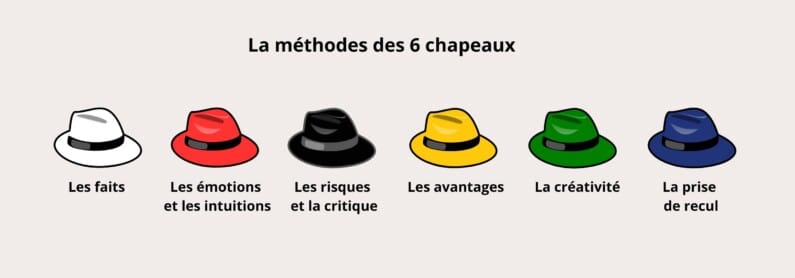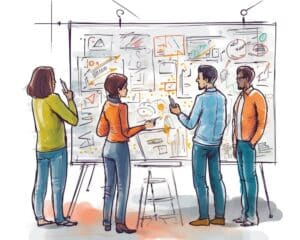How is creativity defined in a professional context? How does it relate to productivity? And why boost it? ORSYS trainer Sandrine Bertrand provides an overview of the useful - and creative - information you need to know to optimise your team's effectiveness.

What is creativity? When we think of creativity, we often think of artists. It's true that expressing yourself through artistic means in a professional environment can be a highly effective and... explosive vector of communication! Marketing is a good illustration of this, always on the lookout for original ideas, sometimes offbeat or very graphic.
But creativity also means finding solutions to a problem, reinventing the way you work, demonstrating your ability to adapt... Creativity is therefore essential in the professional context.
Creativity is 'natural', innate in a way.
#management special report
This article is part 2 of a special report on management.
[Also read]
[1/3] Delegating and empowering: best practice and concrete results
However, as time goes by, society, codes and values can stifle or curb this creativity. Of course, you need rules. And, at the same time, you need to know how to protect and nurture your creativity as much as possible. freedom to imagine and learn. For the manager, the challenge is to encourage his team's creativity. And to do that, they have to be creative themselves.
The different creative profiles
- Le visionary Innovative with bold ideas, often future-oriented.
- Le director The best way to turn ideas into concrete actions and finished projects.
- Le employeer: prefers to work in a team, excels at co-creation.
- L'investigator I like to explore, research and analyse before creating.
- L'adapter agile and flexible, able to adapt to different situations and creative needs.
When creativity meets challenge
Everyone has a comfort zone. In reality, it is above all comfortable for our brain. Any action that becomes habitual over time saves energy, which the brain loves. But this runs counter to the creative spirit, which thinks outside the box and resists routine.
Habits can sometimes constitute a risk and become counter-productive within a work team.
To evolve and adapt to change, you have to dare to leave your comfort zone and regularly "challenge" yourself.
Examples:
1/ Are you apprehensive about speaking at a meeting or giving a presentation?
Next time you attend a meeting, set yourself the goal of asking at least one question. Practise speaking out loud by filming yourself... in the street! If it's too difficult at first, start in an empty street!
2/ Do you have trouble saying "no" or setting limits?
Go into a shop: voluntarily approach a sales assistant to ask for some information about a product that you are not going to buy. Your challenge is simply to be informed and to respect the limits you set yourself when you entered the shop.
From creativity to productivity
A more creative person means :
- taking the initiative,
- more self-confidence,
- more autonomy,
- a greater ability to adapt to change.
If each individual in a workgroup optimises his or her creativity, the whole team improves over time. This will enable it to become more agileThis means you can be more flexible and boost your productivity under the best possible conditions.
How can you stimulate creativity?
Creativity and productivity go hand in hand. To encourage this winning combination, you also need to dare to "let go" of your team when necessary, while maintaining a frame of reference. Remain benevolent, always listening - even to ideas that might seem the most far-fetched - while keeping the team's objectives clearly in mind. So, how and what to do?
1/ Encouraging curiosity
For example, you can start by encouraging everyone's natural curiosity. Stimulate the desire to learn, to discover new colleagues, new working methods, new concepts, etc.
To remember:
- always communicate openly and fluently
- maintaining exchanges and sharing
- encourage new ideas and thinking
2/ Proposing challenges
Suggest "challenges" whenever possible, in terms of concrete ideas and actions to achieve specific objectives.
Examples:
- Why not organise "live my life" eventsWhere each person takes the other's place or accompanies them for a period of time, to better understand the constraints and different points of view?
- Set up temporary working groups or diverse profiles is also a very good way of enabling everyone to learn from each other and be inspired by new visions.
Encourage and value everyone in your team who has dared to step out of their comfort zone. Every little extra step is a victory.
3/ Exploring methods from elsewhere
Take inspiration from working methods that are very different from your daily routine.
In Denmark, we like to do certain things outdoor team meetings on foot. Moving around and getting some fresh air is an excellent way to get some fresh air and get your brain working at its best!
But we can also move inside. For example: set up a workstation that can be booked by slot on a rotating basis. roleIt's the perfect place to work with your laptop, while walking or even cycling. Excellent for creativity and concentration.
4/ Running meetings using innovative methods and tools
Use innovative meeting and communication tools (software, applications, Klaxoon, etc.).
Dare to use different methods for a team meeting, such as the "6 Hats Method".
6-hat method :
This is an original method, which gives pride of place to all aspects of a situation to be discussed or a problem to be solved as a team. The aim is to identify, as a team :
1 - Factual and neutral elements
→ in other words, what we know about the situation and why we are meeting
2 - Potential issues and risks
3 - The positive aspects
4 - The emotions provoked
5 - Ideas for improvement
6 - To finish with a final selection of response elements
The method is described by Maltese psychologist Edward De Bono in his book The six hats of reflection. Everyone is invited to observe a situation from several angles. Each angle is symbolised by a hat of a different colour. The aims are to break out of habitual patterns of thinking, influenced by emotions, beliefs, etc., to look and work in the same direction at the same time, to counteract ego wars and save time, and ultimately to come up with innovative, workable ideas and solutions.
"Meetings are much quicker when you use the six hats. They last half as long, or even only a third or a quarter of the time.
Edward De Bono

Example:
Frédéric C., a manager, used the 6 Hats method to introduce a new working method in his team.
Its objectives: to be productive and to overcome any obstacles and concerns about the implementation of the new methodology. The results: everyone was able to express their feelings, as well as possible solutions to overcome the negative emotions generated by the new situation. And all without censorship. This phase of the project freed people up to speak and made it easier to listen. The fears expressed were discussed, rationalised and calmed. Spontaneously, Frédéric's team suggested several ideas for support: mutual aid, appointing mentors, and so on.
5/ Playing as a team
Professional team games are excellent vehicles for creativity. For example, ask your team to solve a situation in a limited amount of time, with set resources, etc.
To find out more
Numerous books also offer a host of ideas, to be chosen according to your field and professional constraints, including :
The creativity toolbox - François Debois, Arnaud Groff, Emmanuel Chenevier (Dunod, 3e ed.)
Pro in creativity - Marie Gaillochet, Julie Delahaye (Vuibert)
The creativity toolbox - Edward De Bono (Eyrolles)
Training
Developing your team's creativity
More creativity implies a constructive and flexible mindset. How can you pass this on to your team?
On the programme:
- learn how to assess a team's capacity for innovation
- experiment with the main tools and methods for fostering creativity
- draw up an action plan for your team
Ensuring working conditions: a prerequisite for creativity?
Creativity and productivity can also be stimulated by a a 'healthy' and caring environment. In other words, as comfortable as possible, pleasant and relaxing (rest room...), or with a playful and dynamic side, depending on requirements.
Example:
- group or personalised sports sessions offered by the company
- relaxation during breaks: yoga, sophrology, etc.
- moments of sharing: breakfast with colleagues, team picnics during the lunch break, preparing snacks together...
Promote real breaks is an excellent way to recharge your mental and physical batteries. So you can get off to a flying start.
Recognition → Motivation → Creativity → Productivity
Finally, organise work methods and monitoring as well as possible, while ensuring that everything produced is recognised. Creativity and productivity can also be nurtured through motivation!
It's up to you now! Now's the time to reinvent yourself and give your team a boost!





